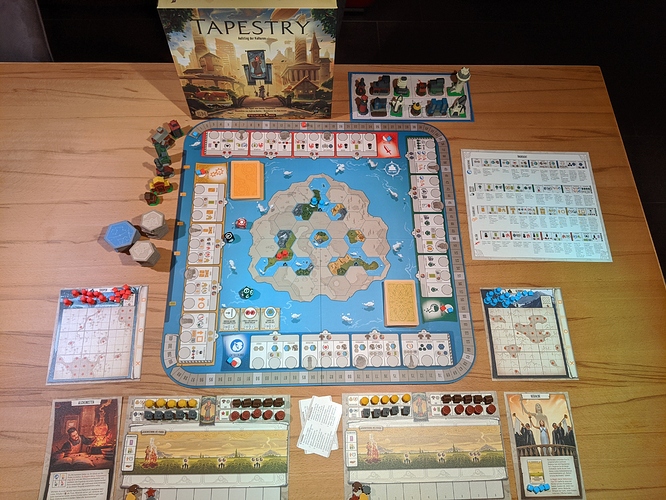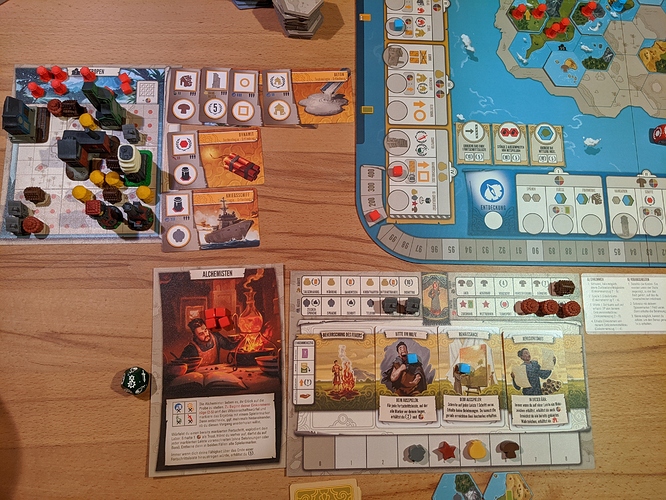After the recent discussion about solo games, I went to my FLGS and acquired… Tapestry (bgg link) because most of the higher ranked games on my list weren’t available and well whatever, I have now played 3 games of Tapestry and since I’ve rarely seen someone mention it in this thread I thought–after last year’s hypeness–some might be interested to know how it went.
- Game 1: me vs myself
- Game 2: me vs the automa (on easy) and the shadow player.
- Game 3: me vs my partner
I won all three games btw.
Setup for Game 1:
Game info
- Listed playtime is 90-120 minutes. Which is optimistic, we would say. 2 hours should be possible when everyone knows the game well.
- 1-5 players, however, the game only functions as it should with 3 or more (second side of board for 4-5 players has a larger map). My guess is that 3 players is ideal if you don’t want the competition for the landmarks to get cutthroat.
- To make 1 and 2 players work the game includes both an automa bot and a shadow player both simulated through the same automa cards (the automa is made by automa factory) and there is a myautoma implementation on github.
- The manual is a bit too short. Once you know the rules it’s good enough to look up details. And after 2 games I was able to remember everything and didn’t need to look up anymore rules. I’d recommend watching a teach video at the start.
How it plays
Setup: Each player receives a unique civilization, a unique tableau for their capital and an income board with 5 buildings in 4 colors. Each player places markers at the start of the 4 advancement tracks and 1 marker on the VP track. Each player places one or two of his “armies” on the hex indicated on his capital city board.
Players play through 5 ages that each start with an income turn which in age 1-4 is followed by as many advancement turns as players can afford. Players take income turns independently which meant in todays game that my partner ended the game a few turns before me. I like this as it means that someone who somehow didn’t manage to do well in age 2 doesn’t have to wait around for the others to finish that age, they simply advance to age 3 and continue playing.
Income turns are pretty complex. This is where some unique civilization abilities get triggered, Tapestry cards get played and technologies advance. Most victory points are awarded during income turns and as a final step each player gets new resources.
Advancement turns are much simpler: the player decides on which of the four tracks (military, discovery, science or technology–translated from German probably different names in English) they want to advance, pays the resource cost, reaps whatever benefit the next slot gives and possibly pays for the bonus.
Each of the four tracks is associated with a certain type of building, and certain game mechanisms and each track feeds back into itself for the most part (though there are some crossover benefits especially from the science track). So if a player wants to advance in a single track they can do that (exceptions apply), it is not necessary to advance in other tracks f.e. to move ahead on technology. In fact, specialization seems to be a decent strategy. Each track has 12 steps, divided into 4 parts and whoever reaches step 4, 7 and 10 first gets the landmark building associated with that step to place into their capital city. The benefits on each track get better and better and the final spot of each track is quite powerful.
Victory points are awarded during discovery of new lands, during conquering of lands, from some advancement slots, Tapestry cards, technologies, civilization powers but most points come from the player income board during income turns depending on how many buildings have already been removed from the board there are points for technologies, conquered lands and how many rows/columns have been completed in the capital.
BGG lists these mechanics and this is how they are actually part of the game
- Dice Rolling: minimal. Players get to roll dice when conquering to determine what type of a reward they get and the science track has special rewards that include advancing on a track that is determined by a die roll
- Hand Management: minimal. Technology cards are played to the tableau immediately, Tapestry cards are drawn to the player hand and one only gets to play three of them (exceptions apply) in the whole game
- Hexagon Grid: player choice. Both discovery and military tracks interact with the map in the center, one can choose to ignore those tracks or focus the whole game on the map both seem valid strategies.
- Solo Mode: it’s an automa, I like the game, it seemed to be a good challenge, will repeat but conquering seems unintuitive and for now it feels a bit on the micromanagment side
- Tech Trees: not trees but 4 linear tracks and some technology cards that can be upgraded.
- Tile Placement: a discovery reward one gets to place a hex tile, I didn’t do this in our last game at all.
- Track Movement: yes. Players do this every turn except on the 5 income turns.
- Variable Player Powers: sure, but of the 4 civs I played so far the powers were almost exclusively confined to the income turns, but they can define what type of tracks you choose. Some tracks work better with some civs than others.
Some criticism
- The material is Stonemaier-nice and has some neat ideas, but not over the top (the building base size of the landmarks is weird)
- The design is more functional than beautiful which is fine by me. I really like that the iconography is clear and only takes 1 game to learn
- There is some interaction between players because players compete for landmarks, technology cards and land they want to conquer. There are also some interactive Tapestry cards and civilization powers. But for the most part the interaction feels “soft” and not very mean–however the more players the meaner it gets I would say, BGG suggests this game is best at 3 and from what I’ve seen, I would concur.
- The theme feels okay but I wouldn’t put it up on the mechanical-thematic harmony thread.
- I would rate it at medium complexity with more depth than it seems at first, especially with 2 interfering bots in the solo. My partner said he felt paralyzed each turn despite there being just 4 tracks to choose from having to consider all the consequences of each action, he had to backtrack several times especially when choosing which resources to spend (there is a lot of “generic” resource gaining and spending).
- The solo mode is fascinating because it has two opponents (both managed by the same automa cards) but I felt the explanation was not well done especially not the examples of when the bot is conquering and the myautoma implementation wasn’t helpful in that regard. Something I nearly overlooked was that a lot of Tapestry cards get removed from solo because they would interact with other players.
- The Feuerland version already has an additional sheet in it balancing the different civilizations a bit more because they definitely aren’t all equally strong.
- The Tapestry cards are definitely not all good… and their effects far less pronounced than the game title suggests…
- Don’t play 2 without the shadow player because the competition for the landmarks is absolutely needed or one person who gets a bit more lucky with how the landmarks and tech buildings fit on their tableau can score a runaway victory (that would be me)
Fazit: Overall this is a solid game, it’s not bad at all, has some depth and replayability and yet for a game of this price I had hoped it was something more… special? It’s weird. I am reasonably sure I can get this on the table again, however I wish it was a less expensive game because I think the material is better than the game and that feels a bit like a waste. My rating: 7.5 / 10 and now I want to play Spirit Island again 

